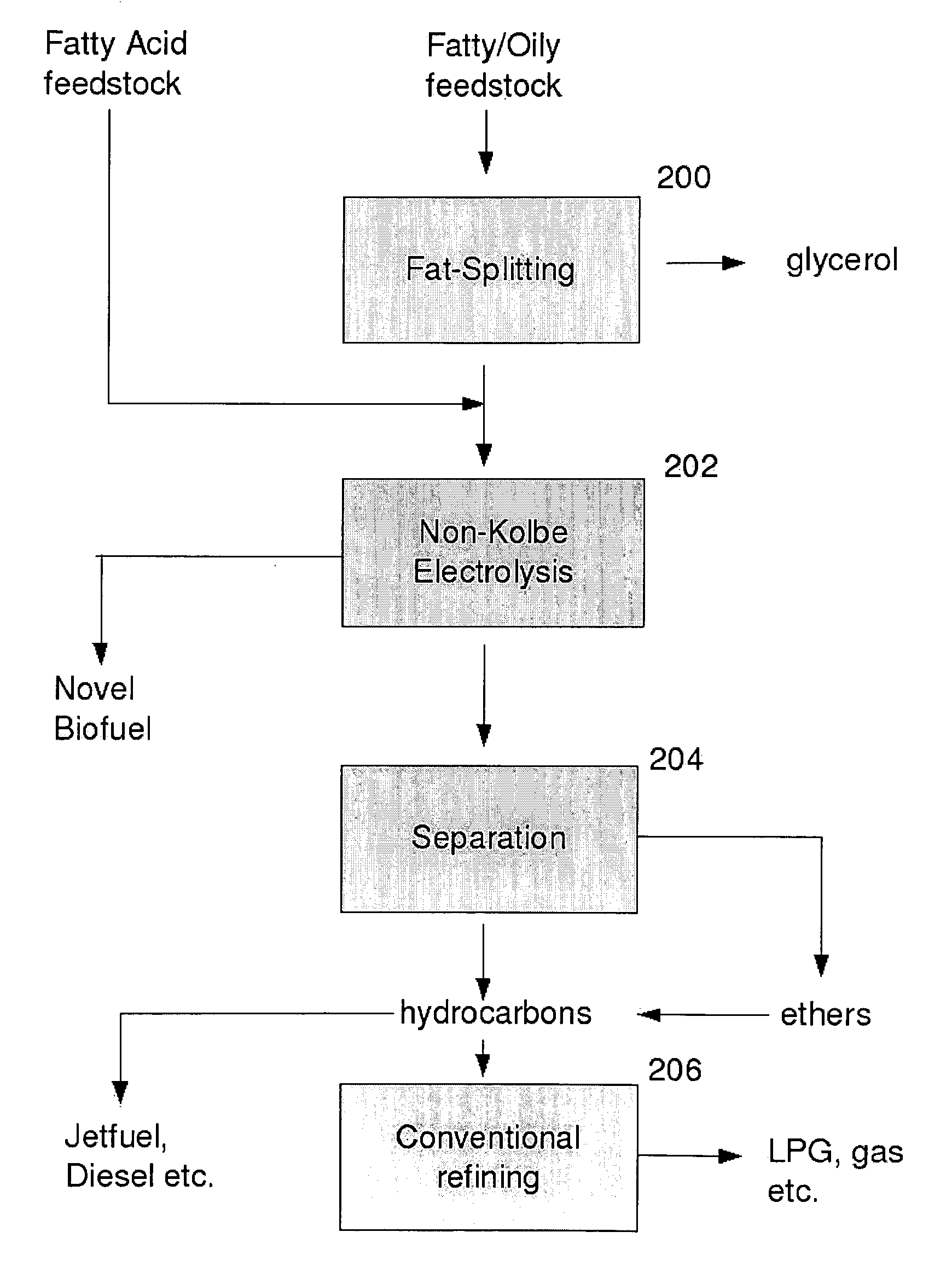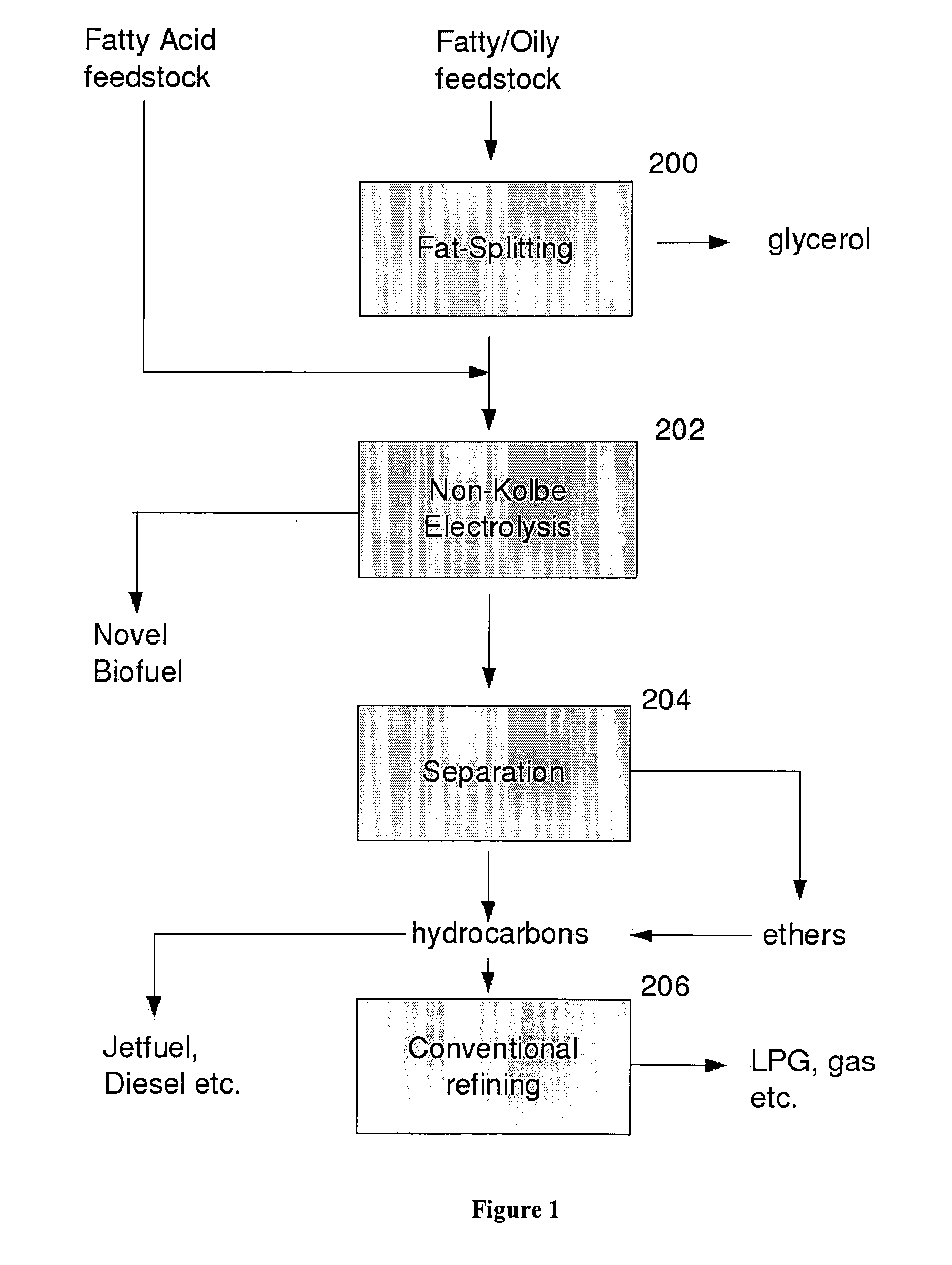Biofuel composition and manufacturing process
- Summary
- Abstract
- Description
- Claims
- Application Information
AI Technical Summary
Benefits of technology
Problems solved by technology
Method used
Image
Examples
example i
Pentenes / Methoxypentanes
[0117]0.25 mol caproic acid was dissolved in approximately 500 ml 99% methanol and made slightly basic with 105% of the theoretically required amount, using 10% methanolic solution of potassium hydroxide.
[0118]This solution was filled up with methanol to produce a 800 ml volume and was poured into a wide reaction vessel of fitting volume equipped with a reflux condenser and two rectangular graphite electrodes approximately 10×10 centimetres in size and of approximately 1-2 mm spacing, connected to a variable DC power supply. The experiment was conducted at room temperature and ambient pressure.
[0119]Cooling water was turned on for the condenser, and the voltage was adjusted for a current density of approximately 0.05 A-cm−2 electrode surface. Carbon dioxide and hydrogen were evolved while the current was flowing.
[0120]An intense scent of pentenes was noticed very shortly after the power was turned on, since pentenes have very low boiling points of approximate...
example ii
Undecenes / Methoxyundecanes
[0123]0.2 mol lauric acid was dissolved in approximately 500 ml 99% methanol, made slightly basic with 10% methanolic solution of potassium hydroxide, filled up to 800 ml, and electrolyzed as above, with similar current density etc. as in Example I.
[0124]The extract consisted of 44-45% undecenes and 43-44% ethers as follows:
1-undecene 5%1-methoxyundecane10%2-undecenes10%2-methoxyundecane16%3-undecenes28%3-methoxyundecane16%4-undecenes 1%4-methoxyundecane 1%5-undecenestrace5-methoxyundecane0.3%
The undecenes occurred in both E and Z variants in varying amounts. N-undecane, undecanols and dodecanoates were also found in quantities at or below 1%.
example iii
Z, Z / E-Heptadecadienes / Methoxy-Z-Heptadecenes
[0125]0.25 mol oleic acid was dissolved in approximately 500 ml technical methanol, made slightly basic with 10% methanolic solution of potassium hydroxide (110% of the theory), filled up to 750 ml, kept at or around 50° C. using a controlled temperature bath and electrolyzed as above, using 120% of the theoretically required current, under similar conditions as in Example I.
[0126]The extract consisted of ˜75% heptadecadienes, ˜20% ethers, and traces of esters etc. The distribution of positional isomers was similar to that in Example II (i.e. the bulk of the isomers were 1,8-, 2,8- and 3,8-E / Z, Z-heptadecadienes, and 1-, 2-, 3-methoxy-Z-heptadecene-8). Those of skill in the art will appreciate from this Example III that heptadecatrienes (characterized by 17 carbon atoms and three double bonds) would be produced using similar techniques to yield similar results, as well as with using lower or higher homologues or more unsaturated acids as ...
PUM
| Property | Measurement | Unit |
|---|---|---|
| Length | aaaaa | aaaaa |
| Molar density | aaaaa | aaaaa |
| Temperature | aaaaa | aaaaa |
Abstract
Description
Claims
Application Information
 Login to View More
Login to View More - R&D
- Intellectual Property
- Life Sciences
- Materials
- Tech Scout
- Unparalleled Data Quality
- Higher Quality Content
- 60% Fewer Hallucinations
Browse by: Latest US Patents, China's latest patents, Technical Efficacy Thesaurus, Application Domain, Technology Topic, Popular Technical Reports.
© 2025 PatSnap. All rights reserved.Legal|Privacy policy|Modern Slavery Act Transparency Statement|Sitemap|About US| Contact US: help@patsnap.com



